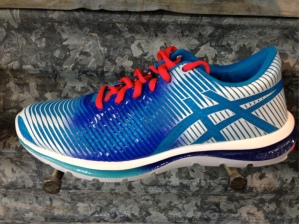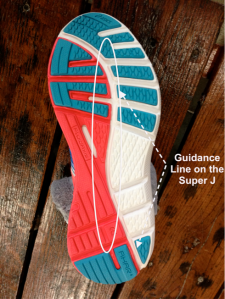By Chris MacLeod
It’s officially fall! You know what that means: The leaves are turning (somewhere up north), there’s a chill in the air (according to people who live by the turning leaves), and there’s a pumpkin patch around every corner (of HEB).
Okay, so the leaves are still green, the air is still hot, and those plastic pumpkins get creepy after a while. But hey, it’s fall in Austin, and at least we have new shoes for the holidays!
Just in this week from ASICS – two shoes that couldn’t be more different. For the sake of instant gratification, let’s start with the new kid on the block.
Introducing the latest member of the Natural33 line: The GEL-Super J33.
About ASICS Natural33 Line
To me, the best way to describe the ASICS Natural33 line of shoes is…umm…how to be tactful here…
Oh, forget it.
These are ASICS modern shoes. The ones that would scare a runner who accidentally time-traveled here from 1994. They’re brightly-colored, lighter in weight, have lots of techy-sounding features, and are clearly the fun project to be on for anyone in ASICS R&D.
The 33 in “Natural33” represents the 33 joints in the human foot, with which these shoes are meant to interact in “a more natural biomechanical way”. I’m not entirely sure what that means, but my take is this:
After years of success in the world of big, structured shoes, ASICS introduced this line in 2011 – roughly around the time Rogue’s “less is more” shoe philosophy took the running world by storm. (And not long after a little book called Born to Run came out.)
GEL-Super J33 Overview
 First let’s admire the pretty colors. I think they ordered both the men’s and women’s in blue so they would be really easy for employees to confuse in the stockroom.
First let’s admire the pretty colors. I think they ordered both the men’s and women’s in blue so they would be really easy for employees to confuse in the stockroom.
Like all shoes in the Natural33 line, the Super J is built around what ASICS refers to as FluidAxis technology, a pair of intersecting grooves that cut through the bottom of the shoe and allow it to flex in multiple directions and follow the rolling, lateral motion of the human foot.
If you’re having trouble picturing this, check out http://www.asicsamerica.com/natural33 for videos. (with very Tron-like soundtracks!)
The Super J, specifically, is marketed as a lightweight, short-distance trainer for mild to moderate overpronators. In its promo video, ASICS 800m athlete Alysia Montano touts the Super J as a go-to for tempo runs or even as a replacement for track spikes.
The official specs, for you tech geeks:
Weight:7.3oz (M) and 6.2oz
Heel/Toe Drop: 6mm (M & W, 20/14mm & 19/13mm)
Design Features: GEL heel cushioning, Solyte Midsole, AHAR high-abrasion rubber for durability, seamless, one-piece upper with steamed-on decoration, FluidAxis groove system, Guidance Line
Available Sizes: 7-15 (M) and 5-12
Available Widths: Standard
MSRP: $100
My feet aren’t sensitive enough to notice all 33 joints moving around the FluidAxis, but given my general lack of flexibility, ASICS could probably design a Natural13 line and for me it would work just as well.
That said, I did notice this shoe felt very flexible as soon as I put it on, which is probably due to a combination of the FluidAxis, the Solyte Midsole (a lighter, slightly firmer material than their traditional EVA foam), and the super-soft upper.
Naturally, I immediately pulled the shoe back off and performed the patented squish-test. (Note: This is not an official test, nor is it patented. However, it’s effective for demonstrating shoe flexibility.)
As you can see, the heel is fairly stiff, but gives way to a very bendy forefoot, a combo I personally like in a shoe. Business in the heel, party in the toes!
How it Fits:
The Super J is only available in standard width, but like most ASICS, it felt a bit wide on my average-to-narrow foot. (When fitting customers, I often have success pulling ASICS for wider feet.)
The width wouldn’t have been an issue were it not for the super-soft upper, which turned into a bit of a “bunched-up upper” when I cinched the laces. The shoe also felt slightly long in my usual size 9, but not enough to go down to an 8.5.
 Cedar Park’s resident shoe guru, Travis, asked if I felt the creasing on the tops of my toes. (Answer: “I didn’t before, but now that you mention it, it’s all I can think about.” So thank you, Travis.)
Cedar Park’s resident shoe guru, Travis, asked if I felt the creasing on the tops of my toes. (Answer: “I didn’t before, but now that you mention it, it’s all I can think about.” So thank you, Travis.)
I certainly wouldn’t eliminate this shoe based on the bunching alone – a lot of shoes do this on my feet, I like to think it makes them look “delicate and feminine” – but check for any potential rubbing when you try the shoe.
How it Feels:
As a fairly severe overpronator, I’m always curious to try shoes that are both “lightweight” and “designed for stability”. Perhaps it shows a lack of imagination, but these two ideas just don’t gel in my head.
Perhaps I should have known something was up when I found the Super J in our “lightweight” section of the stockroom.
From the minute I slipped this shoe on, I felt very little in the way of support. That’s not a negative – this is Rogue, and we believe in fitting the least shoe that will keep you healthy and comfortable – but it does seem to contradict the marketing materials.
After further research, I determined that the “support” features of this shoe are the Guidance Line, which I suppose does give your foot a vague suggestion of how to land, and the slightly denser foam on the medial (inner) side of the shoe.
However, since pretty much all shoe manufacturers are doing some form of guidance these days, you’re not likely to notice much impact if you’re coming from a traditional trainer.
How it Feels Part II (The Interlude):
About halfway through my wear-test, I got distracted – some customers came in and I had to do my real job – and even after standing around (read: squashing down the cushion) in the Super J for 45 minutes, I still didn’t feel any true arch support. Different runners will argue different meanings for the word “support”. And yes, I’d rather stand around in the Super J than, say, a racing flat. BUT…if you’re looking for a shoe to literally hold your foot up, this one isn’t it.
Also, towards the end of the 45 minutes, I did start to feel my heel a bit. And then the joint behind my big toe. Though the GEL offers plenty of cushion for running, like most lightweight shoes, the Super J isn’t designed for standing around. In other words, save it for running, don’t wear it to Six Flags.
How it Runs:
If I’m starting to sound down on the Super J, here’s where I turn things around: This shoe runs fast!
At 6.2 oz in the women’s version, it’s extremely light, which makes quick turnover feel easy. The heel fits snug but not tight, so slippage is not an issue. The relative stiffness of the midsole makes the shoe feel anchored enough to change direction quickly in a pinch, while the GEL under foot provided adequate-but-not-distracting cushion.
I also found the (relatively) thick, firm heel did a bit of stabilization work for me in that I didn’t have to over-engage my calf to keep my foot aligned. That said, runners with stronger, more flexible feet might find the heel bulky for a racer. (In fact, one such runner flat out deemed it “too soft” for a racer – which I translated as meaning he wanted his foot doing more of the work.)
In contrast to the stiff heel, I found the high forefoot flexibility allowed for good ground-feel and encouraged a forefoot strike. In short, the balance of firm to flexible was right up my weak-footed alley!
I’m excited to see ASICS exploring more modern shoe design, and the Super J is a solid addition to that side of their product offering. This is a fast, lightweight shoe that could be a great trainer or racer for a runner with a neutral foot who wants a little bit more than zero support.
Let’s just not get too carried away by its marketing as a “supportive shoe for overpronators”…
Best Feature: The light weight! The Super J can take on some true racing flats in the heft department.
Other Pros: Support/cushion in the heel, flexibility up front.
Biggest Gripe: The bunching of the upper material.
Other Cons: Might have been my imagination, but all the decoration on this shoe made it feel slightly warm to me. As in temperature warm.
Will it Work for You? If you’re a neutral runner or mild pronator with good flexibility and foot strength, I’d say yes! Could also be a good option for those looking to transition from traditional trainers to lighter weight shoes.
Suggested Uses: Short to mid-distance runs, quality workouts, and races up to 10K.







Wow! Really in depth and truthful review. I’ve been contemplating getting a pair of ASICS running shoes for a while now and this review helped push me to get them.
Thank so much! I’m glad it was helpful!
Great review–thanks! Have you tried the Saucony Fastwitch 6? How would you compare it to this shoe?
Thanks! I have not tried the Fastwitch 6, so unfortunately I can’t give a credible compare. From what I see online, it looks like that shoe might have a bit more cushion and target longer runs? The weight sounds comparable, though.
If I can get my hands on a pair, I’ll definitely get back to you!
Thank you!
Pingback: Asics Gel-Super J33
Pingback: Do You Karhu? (Part I) | The Rundown
Pingback: Asics Gel-Super J33 till Sverige
Pingback: That Time I Went to A Writing Workshop | Running Fiesta
thanks so much for such an in depth review! i have been contemplating whether to get these asics for a while, but i think you have made up my mind! is this an australian website? 🙂
it’s a great review…i wonder if the shoe when you run is noisy…like you listen a heel?
Just in this week from ASICS – two shoes that couldn’t be more different. … glytee.wordpress.com
Just in this week from ASICS – two shoes that couldn’t be more different. … masicse.wordpress.com
Pingback: Shoe Review: ASICS GEL-Super J33 | macleodcm